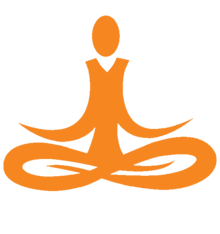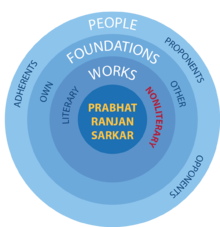Meditation: Difference between revisions
(→top: Add) |
(Fixed link) |
||
| (20 intermediate revisions by 3 users not shown) | |||
| Line 1: | Line 1: | ||
''' | {{#seo: | ||
|keywords=Ananda Marga,meditation,Anandamurti,Sarkar | |||
|description=Ananda Marga,meditation | |||
}} | |||
[[File:Meditation.png|right|220px|PROUT logo]] | |||
[[File:SVmap NonliteraryWorks.png|right|220px|Sarkarverse Map]] | |||
In the teachings of [[Shrii Shrii Anandamurti]], '''meditation''' (or ''dhyána'') is the ultimate spiritual technique for self-realization or God-realization. Its practice affords great inner happiness and peace. According to Anandamurti, the culmination of meditation is ''nirvikalpa samádhi'' (the trance of indeterminate absorption, or total suspension of the mind).<ref name="Sadhana">{{cite book|title=[[Ananda Marga Caryacarya Part 1]]|publisher=[[Ananda Marga Pracaraka Samgha]]|author=[[Anandamurti, Shrii Shrii]]|chapter=[[Sadhana]]}}</ref> | |||
== | == Astaunga Yoga == | ||
'''''Aśt́auṋga Yoga''''' (also known as ''Raja Yoga'', king of yogas) literally means "eight-limbed yoga". It is a selection of ancient practices of ''tantra'', originally compiled by Patanjali (circa 300 BCE) in his book, ''[[:wikipedia:Yoga Sutras of Patanjali|Yoga Sutras of Patanjali]]''. | |||
The eight steps or limbs of Astaunga Yoga include:<ref name="Sadhana" /> | |||
# '''Yama:''' How a person should behave in relation to society. This includes five sub-branches. | |||
# '''Niyama:''' Self-regulated conduct. This also includes five sub-branches. | |||
# '''Ásana:''' [[:wikipedia:Asana|Asanas]] are physical postures designed to cure physical or psychic problems, which in turn impede spiritual progress. | |||
# '''Práńáyáma:''' Breath control to help the mind concentrate in meditation. | |||
# '''Pratyáhára:''' Withdrawing the mind from the external world, as part of meditation. | |||
# '''Dhárańá:''' Concentrating the mind at a particular point. | |||
# '''Dhyána:''' Meditation (an unbroken flow of the mind towards the supreme goal). | |||
# '''Samádhi:''' Merger or absorption of the individual consciousness into the cosmic consciousness. (This is the ultimate result of the previous seven limbs.) | |||
== | === Commentary by Anandamurti === | ||
[[Anandamurti]] notes that the practice of ''aśt́auṋga yoga'' fill one's individual self with the sense of universal consciousness in three stages—<ref name="AMIWL">{{cite book|title=[[Ananda Marga Ideology and Way of Life in a Nutshell Part 9]]|publisher=[[Ananda Marga Pracaraka Samgha]]|author=[[Anandamurti, Shrii Shrii]]|chapter=[[The Science of Action]]}}</ref> | |||
# In the first stage, the individual mind is freed from material or mundane influences so it can concentrate more on the spiritual goal. This stage consists of the first four limbs of ''aśt́auṋga yoga''. | |||
# In the second stage, the individual becomes conscious of her/his spiritual nature (realizing that s/he is not the body). This stage consists of the next two limbs of ''aśt́auṋga yoga''. | |||
# In the final stage, the individual directs her/his unit identity (or small self) toward the great self (cosmic consciousness) through ''meditation'', ultimately merging in that supreme desideratum. This stage consists of the final two limbs of ''aśt́auṋga yoga''. | |||
== Meditation systems in Ananda Marga == | |||
There are numerous types of meditation. In the [[Ananda Marga]] system, as developed by Anandamurti, there are various levels of meditation practice, depending on the needs and qualifications of the spiritual aspirant. All meditation lessons are taught by [[acaryas]] free of charge to any qualified and interested person.<ref name="TPOI">{{cite book|title=[[Ananda Marga Caryacarya Part 1]]|publisher=[[Ananda Marga Pracaraka Samgha]]|author=[[Anandamurti, Shrii Shrii]]|chapter=[[The Process of Initiation]]}}</ref><ref name="YTP">{{cite book|title=[[Yogic Treatments and Natural Remedies]]|publisher=[[Ananda Marga Pracaraka Samgha]]|author=[[Sarkar, Prabhat Ranjan]]|chapter=[[Preface]]}}</ref> | |||
=== Nama Mantra === | |||
Náma mantra is a preliminary form of meditation that may be taught to children after the age of five by a parent, sibling, or guardian. After the age of twelve, the child should take [[The Process of Initiation|initiation]] from an acarya in a more advanced form of yoga.<ref name="TPOI" /> | |||
=== Sahaja Yoga === | |||
Sahaja yoga is the standard system of meditation system taught in Ananda Marga. It consists of six meditation lessons, using concepts and practices similar to ''astaunga yoga''. These are taught step by step over a period of time by one's acarya. As practitioners of this system of yoga are expected to practice ''[[asanas]]'', they must also maintain a sentient vegetarian diet.<ref name="TPOI" /> | |||
=== Prarambhika Yoga === | |||
Prárambhika yoga is an elementary form of meditation. It consists of the first two lessons of ''sahaja yoga''. It is taught to those for whom it is inconvenient to do the more extensive forms of meditation in ''sádhárańa'' or ''sahaja yoga''. As there is no requirement for ''ásanas'' in this system, there are no dietary restrictions. If one's circumstances change, it is possible to then learn the more advanced practices in the Ananda Marga system.<ref name="TPOI" /> | |||
=== Sadharana Yoga === | |||
Sádhárańa yoga is an intermediate form of meditation. It is taught to children from the age of 12-16, to those for whom the standard ''sahaja yoga'' is inconvenient to practice, and to anyone else who for some other reason cannot practice ''sahaja yoga''. It does not include all of the meditation lessons of ''sahaja yoga'', and there are some differences between ''sádhárańa'' and ''sahaja yoga'' in the way that the lessons are taught. There are no dietary restrictions in ''sádhárańa yoga'', because ''ásanas'' are not required in this system. However, ''ásanas'' may be taught if deemed necessary.<ref name="TPOI" /> | |||
=== Vishesa yoga === | |||
Visheśa yoga is an advanced form of meditation. It is for those who are adept in the practices of ''sahaja yoga'', who have an ardent desire to learn this higher yoga, and who can afford to devote sufficient time every day for the same. ''Vishesha'' is only taught by the [[Purodha|purodhás]] of Ananda Marga.<ref name="TPOI" /> | |||
== References == | == References == | ||
{{reflist}} | {{reflist}} | ||
[[Category: | [[Category:Meditation]] | ||
[[Category:Articles lacking infobox]] | |||
Latest revision as of 04:18, 2 August 2023
In the teachings of Shrii Shrii Anandamurti, meditation (or dhyána) is the ultimate spiritual technique for self-realization or God-realization. Its practice affords great inner happiness and peace. According to Anandamurti, the culmination of meditation is nirvikalpa samádhi (the trance of indeterminate absorption, or total suspension of the mind).[1]
Astaunga Yoga
Aśt́auṋga Yoga (also known as Raja Yoga, king of yogas) literally means "eight-limbed yoga". It is a selection of ancient practices of tantra, originally compiled by Patanjali (circa 300 BCE) in his book, Yoga Sutras of Patanjali. The eight steps or limbs of Astaunga Yoga include:[1]
- Yama: How a person should behave in relation to society. This includes five sub-branches.
- Niyama: Self-regulated conduct. This also includes five sub-branches.
- Ásana: Asanas are physical postures designed to cure physical or psychic problems, which in turn impede spiritual progress.
- Práńáyáma: Breath control to help the mind concentrate in meditation.
- Pratyáhára: Withdrawing the mind from the external world, as part of meditation.
- Dhárańá: Concentrating the mind at a particular point.
- Dhyána: Meditation (an unbroken flow of the mind towards the supreme goal).
- Samádhi: Merger or absorption of the individual consciousness into the cosmic consciousness. (This is the ultimate result of the previous seven limbs.)
Commentary by Anandamurti
Anandamurti notes that the practice of aśt́auṋga yoga fill one's individual self with the sense of universal consciousness in three stages—[2]
- In the first stage, the individual mind is freed from material or mundane influences so it can concentrate more on the spiritual goal. This stage consists of the first four limbs of aśt́auṋga yoga.
- In the second stage, the individual becomes conscious of her/his spiritual nature (realizing that s/he is not the body). This stage consists of the next two limbs of aśt́auṋga yoga.
- In the final stage, the individual directs her/his unit identity (or small self) toward the great self (cosmic consciousness) through meditation, ultimately merging in that supreme desideratum. This stage consists of the final two limbs of aśt́auṋga yoga.
Meditation systems in Ananda Marga
There are numerous types of meditation. In the Ananda Marga system, as developed by Anandamurti, there are various levels of meditation practice, depending on the needs and qualifications of the spiritual aspirant. All meditation lessons are taught by acaryas free of charge to any qualified and interested person.[3][4]
Nama Mantra
Náma mantra is a preliminary form of meditation that may be taught to children after the age of five by a parent, sibling, or guardian. After the age of twelve, the child should take initiation from an acarya in a more advanced form of yoga.[3]
Sahaja Yoga
Sahaja yoga is the standard system of meditation system taught in Ananda Marga. It consists of six meditation lessons, using concepts and practices similar to astaunga yoga. These are taught step by step over a period of time by one's acarya. As practitioners of this system of yoga are expected to practice asanas, they must also maintain a sentient vegetarian diet.[3]
Prarambhika Yoga
Prárambhika yoga is an elementary form of meditation. It consists of the first two lessons of sahaja yoga. It is taught to those for whom it is inconvenient to do the more extensive forms of meditation in sádhárańa or sahaja yoga. As there is no requirement for ásanas in this system, there are no dietary restrictions. If one's circumstances change, it is possible to then learn the more advanced practices in the Ananda Marga system.[3]
Sadharana Yoga
Sádhárańa yoga is an intermediate form of meditation. It is taught to children from the age of 12-16, to those for whom the standard sahaja yoga is inconvenient to practice, and to anyone else who for some other reason cannot practice sahaja yoga. It does not include all of the meditation lessons of sahaja yoga, and there are some differences between sádhárańa and sahaja yoga in the way that the lessons are taught. There are no dietary restrictions in sádhárańa yoga, because ásanas are not required in this system. However, ásanas may be taught if deemed necessary.[3]
Vishesa yoga
Visheśa yoga is an advanced form of meditation. It is for those who are adept in the practices of sahaja yoga, who have an ardent desire to learn this higher yoga, and who can afford to devote sufficient time every day for the same. Vishesha is only taught by the purodhás of Ananda Marga.[3]
References
- ^ a b Anandamurti, Shrii Shrii "Sadhana" Ananda Marga Caryacarya Part 1 Ananda Marga Pracaraka Samgha
- ^ Anandamurti, Shrii Shrii "The Science of Action" Ananda Marga Ideology and Way of Life in a Nutshell Part 9 Ananda Marga Pracaraka Samgha
- ^ a b c d e f Anandamurti, Shrii Shrii "The Process of Initiation" Ananda Marga Caryacarya Part 1 Ananda Marga Pracaraka Samgha
- ^ Sarkar, Prabhat Ranjan "Preface" Yogic Treatments and Natural Remedies Ananda Marga Pracaraka Samgha

